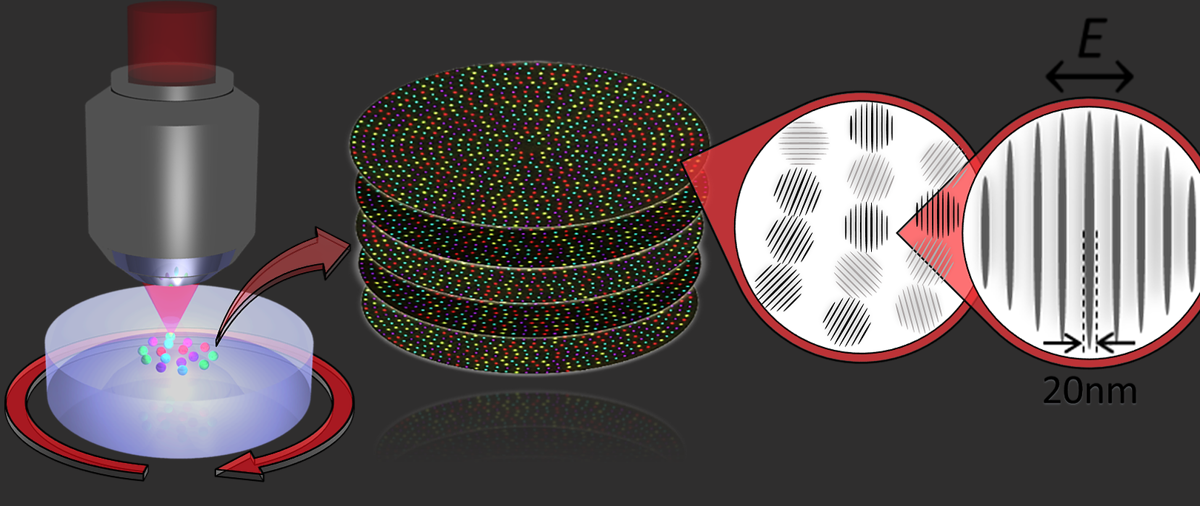
The 21st century has seen rapid growth in our ability to store and access data. The Internet is increasingly bringing all forms of information technology to everyone’s fingertips, making life faster, more informative and more enjoyable than ever. However, with individuals and organizations generating ever-larger datasets, we are in desperate need of more efficient forms of data storage that have a high capacity, low energy consumption and long lifetime. The explosion in digital information is the record of 21st century human civilization, just like ancient cave art, carvings and printings give as a handle on ancient history. But this vital data is at the risk of being lost as current storage technologies are increasingly challenged in capacity and lifetime. It is therefore paramount that information from every sector, ranging from education and entertainment to health and government, is stored for at least thousands of years.
Recently, researchers have made promising progress towards a high capacity optical memory that lasts not decades but perhaps as long as billions of years. Based on ultrafast laser induced nano-gratings fabricated in fused quartz, our team at the University of Southampton in the UK have been able to demonstrate a novel “5D” optical memory that promises essentially limitless data storage.
CDs only have two dimensions in which to store information: tiny pits on the CD surface either reflect or do not reflect laser light to convey the 1s and 0s of binary data in a single layer of plastic. In DVDs the data is stored by burning pits on multiple layers, adding a third storage dimension. In contrast, 3D optical storage techniques potentially allow us to write thousands of “layers” in a single monolithic disc without adding a single physical layer. In order to increase the data capacity of optical storage, there is the potential of storing more than one bit in a single voxel by implementing multiplex technology. The recently developed 5D optical storage technique uses birefringence as an extra degree of freedom – the property of a medium whereby its refractive index varies depending on the polarization and direction of incident light. Birefringence generated by the orientation and size of optical nano-gratings offers two extra dimensions, providing much higher storage capacities. By recording data with tighter focusing optics and shorter wavelength light, it is possible to achieve a spatial (3D) densification similar to that in Blu-Ray discs, involving a pit size of less than 200 nm. Combined with the fourth and fifth dimensions provided by birefringence, which allow a single pit to store eight bits (one byte) of information as opposed to one, it would be possible to achieve an unprecedented capacity of hundreds of terabytes in a single 12cm-diameter disc. Perfecting 5D storage technology would therefore be a major step towards preserving the digital age for future generations.

5D optical memory is far superior, especially when applied to fused silica which has a high chemical and thermal stability. The lifetime of 5D memory is 1020 years at room temperature, indicating unprecedented stability among all techniques. Besides the benefits of multiplexing, 5D optical data based on nanogratings can be also erased and rewritten - which are two key features when considering data storage.

The subwavelength periodicity of these nanostructures behaves as a uniaxial anisotropic material where the optical axis is parallel to the direction of laser polarization. Since the optical anisotropy (called “form birefringence”) is of the same order of magnitude as positive birefringence in crystalline quartz, the perpendicular components of the light possess different propagation constants. This changes the way light travels through the glass, thus modifying its polarization, which can then be read by a combination of an optical microscope and a polarizer similar to that found in Polaroid sunglasses to represent multi-bit information.
Analysing polarization and intensity maps provided by the polarization sensitive microscope the coded information is retrieved .
References:
(1) Seemingly Unlimited Lifetime Data Storage in Nanostructured Glass. Phys. Rev. Lett. 2014, 112 (3), 33901.
(2) Eternal 5D Data Storage by Ultrafast Laser Writing in Glass. In Laser-based Micro- and Nanoprocessing X; 2016; 97360U.
